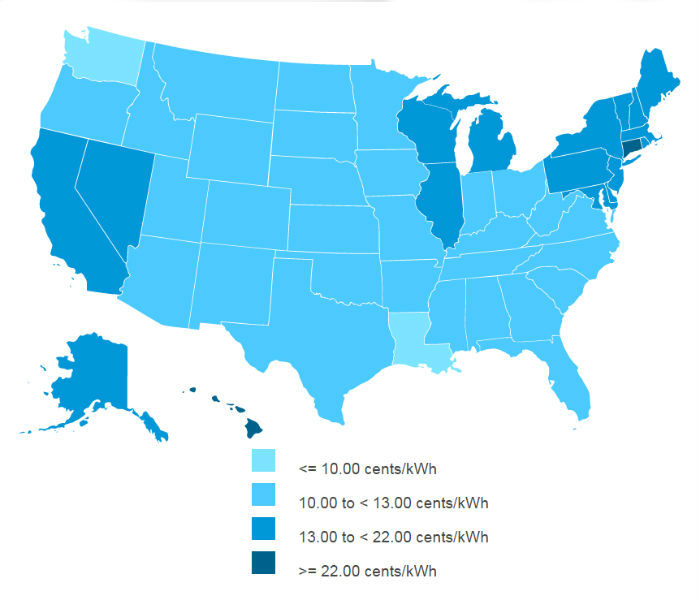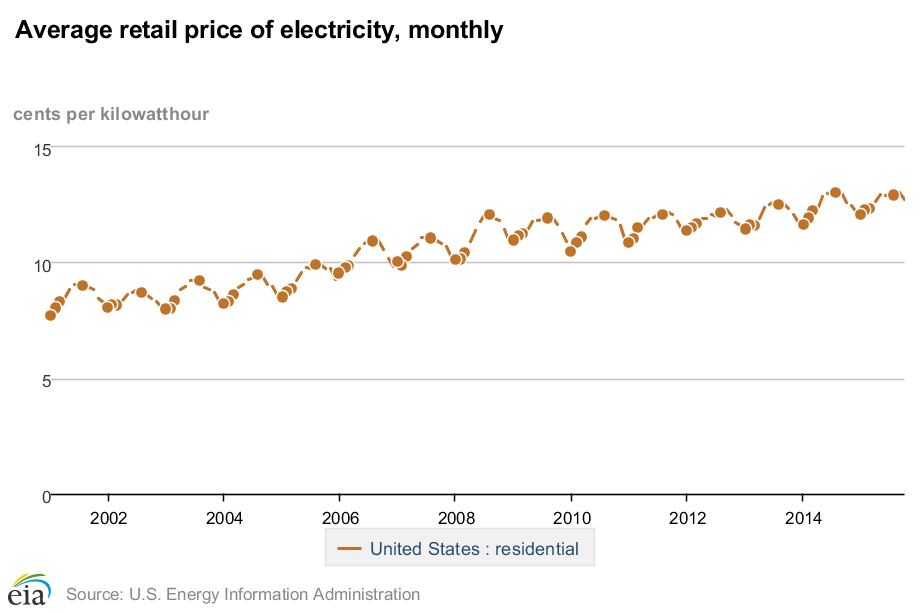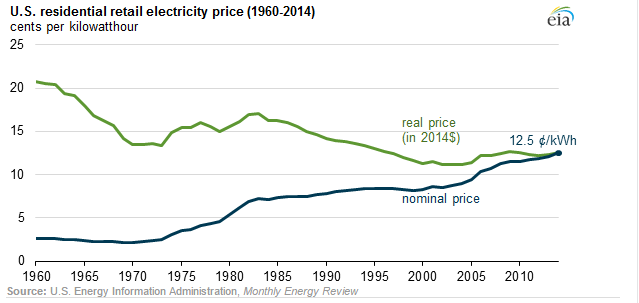Electricity Prices by State in 2016
Electricity prices increase every year, and 2016 is no different. However, depending on where you live in the United States, there are ways you can pay less for electricity. Here’s what you need to know about the price of electricity in the US in 2016.

The Price of Electricity per Kilowatt-hour
According to the US Energy Information Administration, the average national price of electricity in 2016 is projected to stay the same as it was in 2015, at about about 12.7 cents per kWh. With average US household consumption at roughly 10,908 kWh per year, this works out to roughly $115 per month, or about $1385 a year.
Keep in mind, however, that the actual price of electricity per kWh will vary depending on where you live, how much electricity you consume, and may even change depending on the time of day that you use it. What's more, a lower rates doesn't necessarily make for a lower overall bill - while states like Louisiana enjoy some of the lowest rates in the country, hot weather (and subsequent air conditioning usage) means that the typical Louisiana energy bill is greater than states with more expensive power rates and moderate climates (such as Northern California).
Find Out MoreWhat is a Kilowatt-Hour?
Price of Electricity by State
For a variety of reasons, including regional taxes, local power generation sources, and delivery costs, electricity prices vary by state. According to data from fall 2015, the cheapest state for residential electricity is Washington, at 9.41 cents/kWh, while the most expensive electricity is in Hawaii, at 28.22 cents/kWh. Such a dramatic difference in price per kWh reflects different costs of generating electricity; whereas Washington is lucky to have abundant supply of relatively cheap hydropower, Hawaii relies on expensive oil imports as fuel for its electricity generation.
| Census Division and State | October 2015 | October 2014 |
|---|---|---|
| New England | 18.37 | 17.82 |
| Connecticut | 20.05 | 20.38 |
| Maine | 14.87 | 15.82 |
| Massachusetts | 18.37 | 16.90 |
| New Hampshire | 17.73 | 18.07 |
| Rhode Island | 19.68 | 17.19 |
| Vermont | 17.44 | 17.39 |
| Middle Atlantic | 16.31 | 16.28 |
| New Jersey | 15.55 | 15.58 |
| New York | 18.38 | 19.43 |
| Pennsylvania | 14.49 | 13.42 |
| East North Central | 13.41 | 13.46 |
| Illinois | 13.47 | 13.52 |
| Indiana | 11.77 | 12.21 |
| Michigan | 14.59 | 14.70 |
| Ohio | 12.89 | 13.12 |
| Wisconsin | 14.87 | 13.91 |
| West North Central | 11.70 | 11.37 |
| Iowa | 11.70 | 11.21 |
| Kansas | 12.34 | 12.78 |
| Minnesota | 12.76 | 12.35 |
| Missouri | 11.07 | 10.64 |
| Nebraska | 10.95 | 10.73 |
| North Dakota | 10.59 | 9.77 |
| South Dakota | 11.70 | 11.22 |
| South Atlantic | 11.94 | 11.98 |
| Delaware | 14.40 | 14.63 |
| District of Columbia | 13.90 | 13.17 |
| Florida | 11.61 | 11.91 |
| Georgia | 11.09 | 11.42 |
| Maryland | 15.35 | 13.97 |
| North Carolina | 12.11 | 11.89 |
| South Carolina | 12.65 | 12.83 |
| Virginia | 11.52 | 11.57 |
| West Virginia | 10.98 | 9.71 |
| East South Central | 11.11 | 10.97 |
| Alabama | 12.00 | 11.74 |
| Kentucky | 10.74 | 10.51 |
| Mississippi | 11.16 | 11.49 |
| Tennessee | 10.63 | 10.36 |
| West South Central | 11.01 | 11.43 |
| Arkansas | 10.00 | 9.87 |
| Louisiana | 9.55 | 9.70 |
| Oklahoma | 11.12 | 10.83 |
| Texas | 11.41 | 12.07 |
| Mountain | 11.91 | 11.71 |
| Arizona | 12.22 | 11.90 |
| Colorado | 11.74 | 11.81 |
| Idaho | 10.32 | 10.20 |
| Montana | 11.29 | 10.72 |
| Nevada | 12.99 | 13.21 |
| New Mexico | 12.71 | 12.67 |
| Utah | 10.58 | 10.16 |
| Wyoming | 11.56 | 11.14 |
| Pacific Contiguous | 13.47 | 12.20 |
| California | 14.98 | 13.35 |
| Oregon | 10.93 | 10.78 |
| Washington | 9.41 | 8.80 |
| Pacific Noncontiguous | 25.07 | 29.50 |
| Alaska | 20.62 | 20.03 |
| Hawaii | 28.22 | 36.17 |
| U.S. Total | 12.73 | 12.60 |
Source: EIA
Note: these figures are for the month of October in 2014 and 2015 only, and are not annual averages
The Price of Electricity in 2016: an upwards trend

Retail electricity prices have been on a steady rise since a historical low point in 2002. While historically rates have risen at lower rates than the general rate of inflation, residential rates jumped by over 3% in 2014, the biggest annual growth rate since 2008.

Why are electricity rates increasing?
Luckily for consumers, the jump in rate increases has slowed since then, largely due to low natural gas prices and reduced demand for energy after a warmer fall and winter. In fact, the EIA predicts that warmer winter temperatures for 2016 (about 15% warmer than last winter) will make for relatively lower heating costs for most households throughout the US: average households that heats primarily with natural gas will spend about 17% less on that fuel this winter compared with last year, and for customers heating with electricity in the Northeast, Midwest, and South (where temperatures have been warmer than expected) the EIA forecasts winter heating expenditures are to be 9% lower than last year.
However, this isn’t expected to last - with major investments in grid modernization and increasing generation capacity for renewables, along with increased environmental efficiency standards, retail electricity prices will only increase in the long term. In fact, the EIA forecasts retail prices to rise again by about 3% in 2017.
Find out more Learn about what factors affect the price of electricity
How to Pay Less for Electricity
Luckily, there are several things you can do to pay less for your energy if your utility bills are making you feel the pinch.
Use Less Energy, Pay Less on Your Bill
Hands down, the most effective thing you can do to reduce your energy bills is to simply use less energy. Throughout most of the US, most of the charges that make up the price of your electricity (supply costs, delivery costs, and state taxes/surcharges) are charged on a cents per kWh basis, so decreasing your monthly consumption can have a big impact on your overall energy bill (unless you live in Texas - find out why). From changing a few simple habits to making some targeted investments in energy efficiency, there are plenty of ways to save energy around the home, and reduce your monthly energy bills in the process.
- Energy Saving Tips
- 15 Awesome Ways to Save on Your Energy Bills
- How to be Smart With Your Appliance Use
- Vampire Energy - what it is and how to avoid it
- How to Stay Cool Without Heating up Your Summer Power Bills
- 10 Ways to Winterize Your Home
Should You Go Solar?
Increasing electricity rates are making home solar more attractive. But is it worth it? Decide for yourself by finding the answers to these questions:
- How many kilowatt-hours does your home use per month on average?
- How much roof area do you have (where you can install panels)? How much of this area is south-facing?
- How many sun hours does your home get per day (averaged over the course of the year)?
- How much can you afford to invest in offsetting your energy bill?
Make sure to check out what kinds of tax incentives are available in your area, and under what conditions you can claim them. There are a number of companies that lease solar panels, which may be an option for customers who don't want to defray up-front costs.
Check out Google's Project Sunroof, which might be able to help you decide whether solar panels are right for you
Compare Electricity Rates and Save
If you live in an area where energy is deregulated, you have the power to choose who supplies your electricity and/or natural gas. This means you have a choice of how much you pay for your energy. Alternate suppliers offer a variety of price and plan length options, and by taking a few minutes to shop around you may able to save on your utility bills.
Call us at phone currently not available (New York customers) or at 832-460-0233 (Texas customers) to speak to an energy expert and find the lowest rate available in your area.